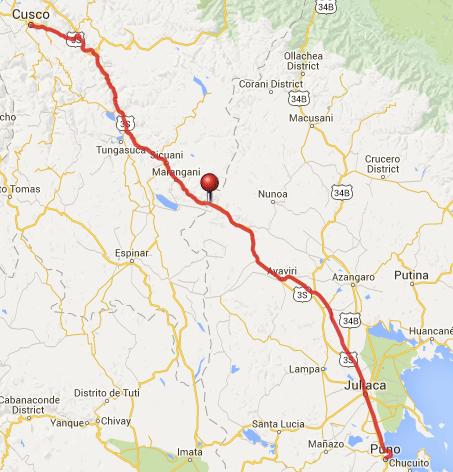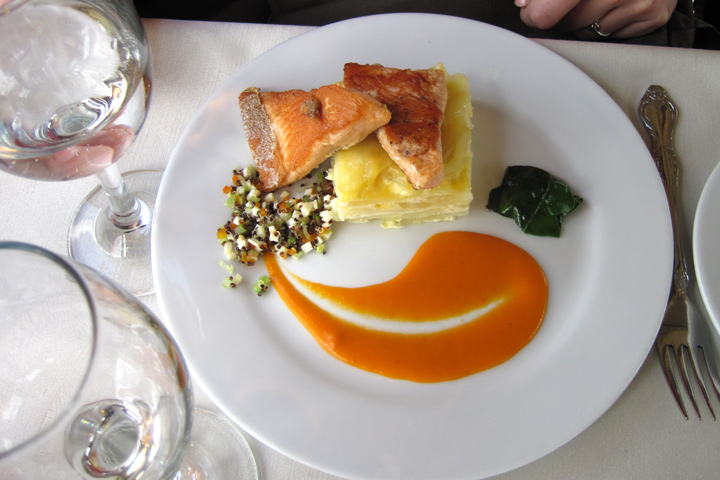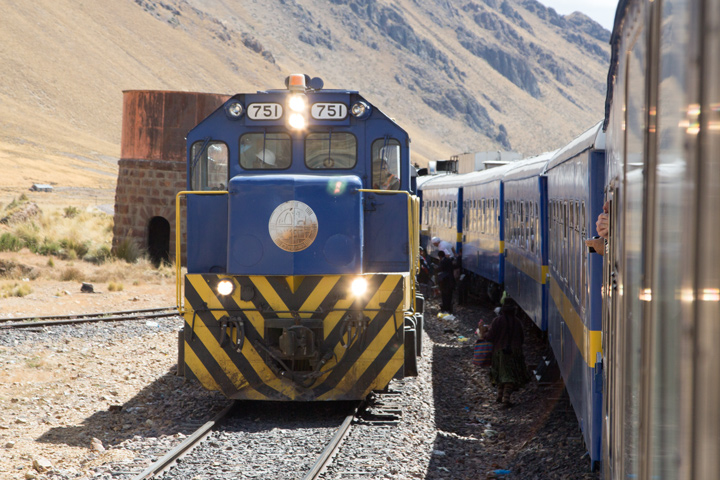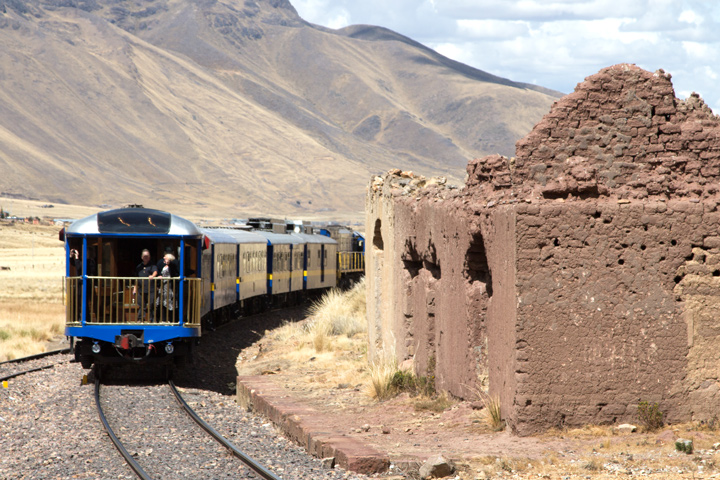Note: This is an account of a journey on the Andean Explorer in August 2015. In 2017, PeruRail introduced a luxury train with sleeping cars called the Belmond Andean Explorer on a Cusco-Puno-Arequipa route. The daytime route described in this article was renamed Titicaca.
Many visitors to Peru experience PeruRail’s trains, especially the popular route from the outskirts of Cusco to Aguas Calientes, the closest town to Machu Picchu. Since Aguas Calientes doesn’t have road connections to the outside world, travelers to the famous Incan settlement have little choice but to ride this bumpy train route in at least one direction. A longer, smoother, and less well known rail experience is PeruRail’s Andean Explorer, which connects Cusco with Puno, a city on the edge of Lake Titicaca. The trains run three or four times a week, with trains departing both northwest and southeast on the same day.

While planning our trip, I learned that PeruRail’s fares were lower traveling from Puno to Cusco (Wanchaq station) than from Cusco to Puno. That suited our planned itinerary coming from Bolivia just fine. The price was $169/person one-way, with the 385 km (240 mile) journey scheduled to take ten hours. (For 2016, the rates are $301/person southbound from Cusco to Puno and $176/person northbound from Puno to Cusco, scheduled to take ten and a half hours.) We purchased our tickets online well in advance.


The morning of Monday, August 17, 2015, Rachel and I caught a taxi from our hotel to Puno’s train station. We arrived well before our scheduled 8:00am departure, since our tickets indicated that if we didn’t arrive by 7:30am we could be denied boarding. This is probably an idle threat since nobody checked our tickets until the boarding call just a few minutes prior to departure. On the outside, the station is nothing spectacular. From the street, the only indication that the building is a train station at all is a small sign reading “PERURAIL BOLETERIA“.
After checking our luggage through to Cusco, we waited for boarding in a small, cozy waiting room. The walls were decorated with classic black and white photos of rail scenes. I had to raise an eyebrow at PeruRail’s use of gas heaters in the waiting room (the sort that one commonly sees heating outdoor seating at restaurants). They didn’t even remove the words reading “For Outdoor Use Only”!

After announcing it was time for boarding, PeruRail personnel examined our tickets and passports. If the train station was underwhelming, the Andean Explorer‘s rolling stock was most impressive. The passenger cars appeared to be vintage but in superb condition, featuring 1×2 easy chair seating. Even the restroom had wood paneling.

The real treat is the lounge/observation car at the end of the train. It features a bar as well as easy chairs and couches. Towards the end of the car is an area with large windows. The observation platform at the very end of the train is open air. Open air cars are a photographer’s dream since shooting through the distortions, reflections, and tints of train windows wrecks a lot of shots.

The northbound Andean Explorer got underway at 8:01am, traveling out of Puno’s rail yard and along the north side of Puno Bay, passing the area where the Coya was docked. The Coya is a vingtage iron-hulled vessel that we’d discovered while looking for the Yavari the previous day.

The train briefly hugged the shore of Lake Titicaca, where flamingos foraged, before heading out across the Alitplano.


Shortly after 9:00am, we reached the outskirts of Juliaca, the first major city (and stop) on our route. On the outskirts was a beautiful, modern building hosting Universidad Andina. The rail line ran parallel to a major road coming into the city decorated with statues. The city was bustling with traffic, including those driving across unprotected railroad crossings seconds after our train passed.

We arrived at Juliaca’s station around 9:15am. Text on the wall of the station indicated the station was 47 km (29.2 mi) from Puno, with another 338 km (210 mi) remaining to Cusco. Juliaca’s rail yard appeared larger than Puno’s and had a number of freight cars. Interestingly, we never encountered any freight trains going the other direction during our journey. Pulling out of the station, an old green steam engine was visible on display.

I was surprised when, after leaving the station, the train proceeded directly through a market. The clearance between the train and the stalls’ canopies couldn’t have been more than a foot on either side. No Federal Railroad Administration regulations here crimping PeruRail’s style!

Despite the comfortable easy chairs in our coach, we spent most of the time before lunch in the lounge car. Staff regularly distributed stacks such as potato chips, dried corn, and mini sandwiches, as well as pisco sours as a “welcome beverage”. Pisco, a kind of brandy, is commonly referred to as Peru’s national alcoholic beverage. Later in the day, there would be a bar tending class instructing passengers how to make the pisco sour, a cocktail that I suppose is more palatable to passengers than straight brandy!

Around 10:30am a group of musicians and a dancer from Puno performed in the lounge car. I know for certain that the group was from Puno because they reminded us of this fact after practically every song. (A group that performed during the second half of the journey referred to this tongue-in-cheek, their spokesman saying with a wry smile that his group was most definitely NOT from Puno!) Like many local groups we’d listened to in Bolivia and Peru, their most distinctive instrument was the zampoña, a kind of pan flute. Even when the group wasn’t performing, the crew often had music playing over the PA system.





After Juliaca, we entered an area with terrain that would be familiar until La Raya Pass. There were dry, grassy fields with the occasional river against a backdrop of rocky mountains. I believe these high altitude grasslands are referred to as puna. Signs of human habitation were occasional but the communities themselves were quite small, sometimes with grazing llama or alpaca herds nearby. At one point we passed through a ghost town built up on both sides of the track.

The scenery was good, but I kept waiting to reach a section of the Andes with snow capped splendor rivaling Bolivia’s Cordillera Real. Unfortunately, it never really happened. Snow appeared on the occasional mountain within an hour’s travel of La Raya Pass, but even most of the mountains towering above the pass had fairly small mantles of snow.


 Around 12:30pm we returned to our seats for a complimentary lunch. The first course was a choice of pumpkin soup or salad. For the main course, I had the rolled chicken in a chili pepper sauce with tomato confit and sides of potatoes and vegetables, while Rachel had the grilled trout in a red pepper sauce with potatoes. (There was also a pasta tart with tomatoes and olives available.) Dessert was cheesecake with strawberries. The meals looked and tasted amazing, though the portions were a bit small (at least by US standards). If not for the regular snacks in the lounge car, we would have been starving by the time we got to Cusco.
Around 12:30pm we returned to our seats for a complimentary lunch. The first course was a choice of pumpkin soup or salad. For the main course, I had the rolled chicken in a chili pepper sauce with tomato confit and sides of potatoes and vegetables, while Rachel had the grilled trout in a red pepper sauce with potatoes. (There was also a pasta tart with tomatoes and olives available.) Dessert was cheesecake with strawberries. The meals looked and tasted amazing, though the portions were a bit small (at least by US standards). If not for the regular snacks in the lounge car, we would have been starving by the time we got to Cusco.

Around 1pm we pulled into a siding surrounded by ruins of railroad buildings. What remained of a large water tank was visible. A photograph displayed aboard the train depicts a steam engine being watered by a similar (if not the same) tank. Steam locomotives needed to be serviced at far more frequent intervals than modern diesel ones.
As our train sat, a pair of local women rushed to the back of the observation platform, shoving trinkets through the bars trying to sell them to passengers on board. As much as I enjoyed the journey, at times I felt a gnawing guilt about being on this luxurious train surrounded by frequent reminders of the poverty that is so common in Peru.

As it turned out, this was the spot where the other Andean Explorer coming southeast from Cusco would be passing us. There was a short delay of maybe seven or eight minutes. I suspect that part of the reason for the delay was that the switches to the siding were operated by hand. The trains also exchanged bands at the very least, and possibly other personnel.

After the southbound train departed, ours resumed its journey. It would only be another 20 minutes to La Raya Pass, the literal high point of our train journey (as well as the highest I’ve ever been outside an airplane, an incredible 4,319 meters or 14,170′).
The next article will explore La Raya Pass and the lusher half of the Andean Explorer journey.

Looks a lot like basin and range territory between Salt Lake and Reno.
LikeLike
Yeah, only three times as high. What’s your verdict on the locomotive…Baldwin or Beyer Peacock?
LikeLike
Wikapedia say Baldwind
LikeLike